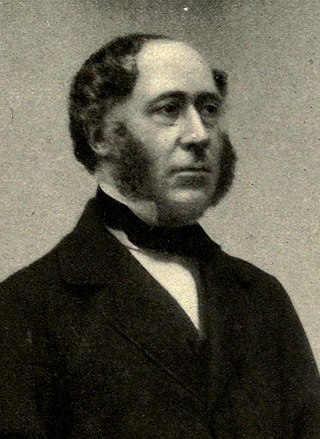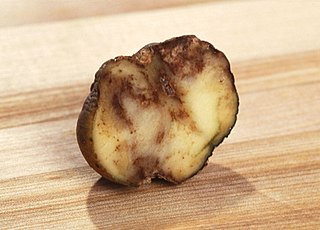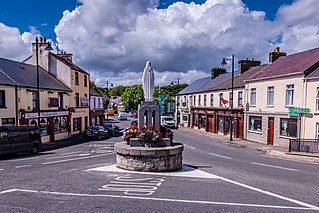Related Research Articles

The Great Famine, also known as the Great Hunger, the Famine and the Irish Potato Famine, was a period of starvation and disease in Ireland lasting from 1845 to 1852 that constituted a historical social crisis and subsequently had a major impact on Irish society and history as a whole. The most severely affected areas were in the western and southern parts of Ireland—where the Irish language was dominant—and hence the period was contemporaneously known in Irish as an Drochshaol, which literally translates to "the bad life" and loosely translates to "the hard times". The worst year of the famine was 1847, which became known as "Black '47". During the Great Hunger, roughly 1 million people died and more than 1 million more fled the country, causing the country's population to fall by 20–25% between 1841 and 1871. Between 1845 and 1855, at least 2.1 million people left Ireland, primarily on packet ships but also on steamboats and barques—one of the greatest exoduses from a single island in history.
The Popery Act of 1704 required land owned by Roman Catholics to be divided equally between all a landholder's sons, both legitimate and illegitimate, on his death. This had formerly been normal under the law of gavelkind, a law abolished by the Dublin administration in 1604. Known as sub-division, this inheritance practice continued by tradition until the middle of the 19th century.

The Irish National Land League, also known as the Land League, was an Irish political organisation of the late 19th century which organised tenant farmers in their resistance to exactions of landowners. Its primary aim was to abolish landlordism in Ireland and enable tenant farmers to own the land they worked on. The period of the Land League's agitation is known as the Land War. Historian R. F. Foster argues that in the countryside the Land League "reinforced the politicization of rural Catholic nationalist Ireland, partly by defining that identity against urbanization, landlordism, Englishness and—implicitly—Protestantism." Foster adds that about a third of the activists were Catholic priests, and Archbishop Thomas Croke was one of its most influential champions.

The Royal Canal is a canal originally built for freight and passenger transportation from Dublin to Longford in Ireland. It is one of two canals from Dublin to the River Shannon and was built in direct competition to the Grand Canal. The canal fell into disrepair in the late 20th century, but much of it has since been restored for navigation. The length of the canal to the River Shannon was reopened on 1 October 2010, but a final spur branch, to Longford Town, remains closed.

A coffin ship is a popular idiom used to describe the ships that carried Irish migrants escaping the Great Irish Famine and Highlanders displaced by the Highland Clearances.

Clonmany is a village and civil parish in north-west Inishowen, in County Donegal, Ireland. The Urris valley to the west of Clonmany village was the last outpost of the Irish language in Inishowen. In the 19th century, the area was an important location for poitín distillation. Outside the village, there are a number of notable townlands, including Kinnea (Rockstown), Crossconnell, Dunaff, and Leenan.

Strokestown, also known as Bellanamullia and Bellanamully, is a small town in County Roscommon, Ireland. It is one of the 27 designated Heritage Towns in Ireland. Located in the part of the country marketed for tourism purposes as Ireland's Hidden Heartlands, it is 140 km (87 mi) from Dublin and 120 km (75 mi) from Galway. Strokestown is one of Ireland's few planned towns, showing evidence of deliberate planning, such as formally aligned streets and prominent public buildings.

George Henry Moore was an Irish politician who, in the 1850s, was a co-founder of the Tenant Right League, of the Catholic Defence Association and, as the Member for Mayo in the United Kingdom Parliament, of the Independent Irish Party. Although an advocate of tenant rights, and renowned for his relief efforts during the Great Famine, at the time of his death in 1870 Moore was defending his rights as a landowner against an oath-bound tenant society, the Ribbonmen. He was the father of the novelist George Augustus Moore and of the Fianna Fáil Senator Maurice George Moore.

The Highland Potato Famine was a period of 19th-century Highland and Scottish history over which the agricultural communities of the Hebrides and the western Scottish Highlands saw their potato crop repeatedly devastated by potato blight. It was part of the wider food crisis facing Northern Europe caused by potato blight during the mid-1840s, whose most famous manifestation is the Great Irish Famine, but compared with its Irish counterpart, it was much less extensive and took many fewer lives as prompt and major charitable efforts by the rest of the United Kingdom ensured relatively little starvation.

Crossmolina is a town in the historical barony of Tyrawley in County Mayo, Ireland, as well as the name of the civil parish and Catholic parish in which the town is situated. The town sits on the River Deel near the northern shore of Lough Conn. Crossmolina is about 9 km (5.6 mi) west of Ballina on the N59 road. Surrounding the town, there are a number of agriculturally important townlands, including Enaghbeg, Rathmore, and Tooreen.
Ballygar is a village in County Galway, Ireland. It is 19 km from Roscommon town.
Lieutenant-General Thomas Mahon, 2nd Baron Hartland, styled Hon. Thomas Mahon from 1800 to 1819, was an Irish soldier, politician and peer. Son of a landed proprietor with an estate at Strokestown, he joined the British Army, serving for most of his career with the 9th Light Dragoons. His garrison skillfully ambushed and destroyed a force of United Irishmen at the Battle of Carlow in 1798. He briefly represented County Roscommon in the Irish and UK Parliaments as part of his father's successful scheme to obtain a peerage by supporting the Union, but this was not popular with the county electors, and he abandoned Parliament in 1802 to return to the military. He had the misfortune to be present at two military debacles of the Napoleonic Wars, the second invasion of the Río de la Plata and the Walcheren Campaign, and while he was not personally implicated in either, he saw no further notable military service. Mahon succeeded his father as Lord Hartland in 1819 and died without issue in 1835, his title and estates passing to his youngest brother.
Baron Hartland, of Strokestown in the County of Roscommon, was a title in the Peerage of Ireland. It was created on 30 July 1800 for Maurice Mahon, who had earlier represented County Roscommon in the Irish House of Commons. He was the son of Thomas Mahon, who also represented this constituency in the Irish Parliament, grandson of John Mahon and great-grandson of Captain Nicholas Mahon.
Maurice Mahon, 1st Baron Hartland, was an Irish politician and landowner. He and his sons intermittently represented County Roscommon in the Parliament of Ireland and the United Kingdom Parliament. He was able to transform his support of the Union of Great Britain and Ireland into a peerage, but was frustrated in his subsequent desire to become a viscount.

Strokestown Park House is a Palladian style Georgian house in Strokestown, County Roscommon, Ireland, set on about 300 acres (120 ha).
The High Sheriff of Roscommon was the British Crown's judicial representative in County Roscommon, Ireland from 1575 until 1922, when the office was abolished in the new Free State and replaced by the office of Roscommon County Sheriff. The sheriff had judicial, electoral, ceremonial and administrative functions and executed High Court Writs. In 1908, an Order in Council made the Lord-Lieutenant the Sovereign's prime representative in a county and reduced the High Sheriff's precedence. However the sheriff retained his responsibilities for the preservation of law and order in the county. The usual procedure for appointing the sheriff from 1660 onwards was that three persons were nominated at the beginning of each year from the county and the Lord Lieutenant then appointed his choice as High Sheriff for the remainder of the year. Often the other nominees were appointed as under-sheriffs. Sometimes a sheriff did not fulfil his entire term through death or other event and another sheriff was then appointed for the remainder of the year. The dates given hereunder are the dates of appointment. All addresses are in County Roscommon unless stated otherwise.
George Joseph Plunket Browne (1795–1858) was an Irish Roman Catholic clergyman. Born to a "well-known Roscommon family", he served as Bishop of Galway from 1831 until 1844, and afterward as Bishop of Elphin, until his death on 1 December 1858. He was charged with being a "Cullenite" in 1855, that is, a follower of ultramontane Paul Cardinal Cullen.
Maurice Mahon, 3rd Baron Hartland was a Church of Ireland clergyman and Irish peer.
Oliver Dowell John Grace was a landowner in County Roscommon and politician who served at various times as a magistrate, a Grand Juror of Roscommon, High Sheriff of Roscommon (1831), and as a member of Westminster Parliament for the county (1847-1859). Grace was elected as a Whig MP in 1847, as an Independent Irish Party MP in 1852, and again as a Whig in 1857. In 1867, Grace was appointed Vice Lieutenant of Roscommon, an office he held until his death five years later.
Aughnasurn, or Aghnasurn is a townland in the civil parish of Kilbryan, County Roscommon, Ireland.
References
- 1 2 3 4 5 6 7 8 9 10 11 12 13 Dunn, Mary Lee (2008). Ballykilcline rising: From Famine Ireland to Immigrant America. University of Massachusetts Press. ISBN 978-1-55849-658-3. JSTOR j.ctt5vk8jg.
- 1 2 3 "Murder of Major Denis Mahon 02.November.1847 | Irish News Archives". www.irishnewsarchive.com. Retrieved 19 January 2022.
- 1 2 "Day 1 Strokestown – Clondra, c. 20km. The Assassination of Major Denis Mahon (November 2nd 1847) – National Famine Way". nationalfamineway.ie. Retrieved 19 January 2022.
- ↑ "About Strokestown Park A unique property". Strokestown Park. Retrieved 19 January 2022.
- 1 2 "Treasures of the Strokestown Famine Archive". Strokestown Park. Retrieved 20 January 2022.
- 1 2 3 4 5 6 Bulik, Mark (1 January 2015). The Sons of Molly Maguire: The Irish Roots of America's First Labor War. Fordham University Press. doi:10.2307/j.ctt1287fxq.8. ISBN 978-0-8232-6225-0. JSTOR j.ctt1287fxq.
- ↑ Jackson, Pauline (1984). "Women in 19th Century Irish Emigration". International Migration Review. 18 (4): 1004–1020. doi:10.2307/2546070. JSTOR 2546070.
- ↑ "Biography – DOUGLAS, GEORGE MELLIS – Volume IX (1861-1870) – Dictionary of Canadian Biography". www.biographi.ca. Retrieved 20 January 2022.
- ↑ "Grosse Ile: Canada's Island Famine Memorial". History Ireland. 28 January 2013. Retrieved 20 January 2022.
- 1 2 Casey, Brian (2009). "Review of The Murder of Major Mahon, Strokestown, County Roscommon, 1847, Maynooth Studies in Local History 80". Irish Economic and Social History. 36: 159–160. ISSN 0332-4893. JSTOR 24338809.
- ↑ Cathaoir, Brendan O. "Local priest faulted after crime". The Irish Times. Retrieved 20 January 2022.
- ↑ "MOTION FOR CORRESPONDENCE. (Hansard, 13 June 1861)". api.parliament.uk. Retrieved 20 January 2022.
- ↑ "STR/1A/154 Printed confessions of Patrick Hasty and Owen Beirne, found guilty of conspiring to murder Major Denis Mahon and Rev John Lloyd, 8 August 1848". Strokestown Park. Retrieved 20 January 2022.